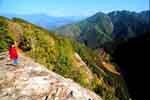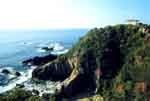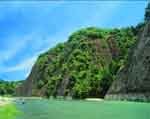
to the top
 This huge rock
wall, created by earthquakes and erosion over the years,
stretches out over 1.2km from east to west. There is a
legend about a pirate called Tagamaru who was defeated by
Sakanouenotamuramaro, a famous general working under the
orders of Emperor Kanmu. The following poem by Yasushi
Inoue is about the demons who were said to reside here:
This huge rock
wall, created by earthquakes and erosion over the years,
stretches out over 1.2km from east to west. There is a
legend about a pirate called Tagamaru who was defeated by
Sakanouenotamuramaro, a famous general working under the
orders of Emperor Kanmu. The following poem by Yasushi
Inoue is about the demons who were said to reside here:'Long ago some demons of Kumano gathered here and lived. They let their hair fly loose in the wind, they laughed at the whirlpools, and slept through in the raging billows that shook the rocks. They preferred a night of thunder to a night of the moonlight. Their horns vivid in the thunder.'
to the top
 This is
Sekiyatou, a layered rock stupa, found in Shimokitayama
Village. Whereas cedars and cypresses in Kumano usually
grow upward, the trees on this mountain spread their
branches wide and try to stick to the precipice, which
gives the impression of their having a strong will to
survive, as if they were living creatures. The contrast
of trees and rock, especially in autumn when the leaves
turn red, is truly enchanting and has a certain mystery
about it.
This is
Sekiyatou, a layered rock stupa, found in Shimokitayama
Village. Whereas cedars and cypresses in Kumano usually
grow upward, the trees on this mountain spread their
branches wide and try to stick to the precipice, which
gives the impression of their having a strong will to
survive, as if they were living creatures. The contrast
of trees and rock, especially in autumn when the leaves
turn red, is truly enchanting and has a certain mystery
about it. to the top
 Standing here
gazing out over the Pacific Ocean one can really feel
that the earth truly is round. The Cape is formed by a
mountain which projects out into the sea and drops
steeply into the sea. Due to the geographical features of
this cape many fish gather around it making it a good
feeding ground for whales and dolphins.
Standing here
gazing out over the Pacific Ocean one can really feel
that the earth truly is round. The Cape is formed by a
mountain which projects out into the sea and drops
steeply into the sea. Due to the geographical features of
this cape many fish gather around it making it a good
feeding ground for whales and dolphins. to the top
 The Great Rock
of Koza is like a natural pyramid growing out of the
bowels of the earth. Near the centre of the great rock
the In-yo (Yin/Yang) Waterfall pours out and down into
the Koza River below. In some years the flowers near the
waterfall bloom throughout the four seasons. The Great
Rock of Koza is considered to be a Japanese National
Monument and is said to be a kind of natural 'power spot'
where the gathering energy of earth can be tangibly felt.
The monolith is approximately 100 meters high and 500
meters wide and seen from afar it looks like a veritable
mountain in itself.
The Great Rock
of Koza is like a natural pyramid growing out of the
bowels of the earth. Near the centre of the great rock
the In-yo (Yin/Yang) Waterfall pours out and down into
the Koza River below. In some years the flowers near the
waterfall bloom throughout the four seasons. The Great
Rock of Koza is considered to be a Japanese National
Monument and is said to be a kind of natural 'power spot'
where the gathering energy of earth can be tangibly felt.
The monolith is approximately 100 meters high and 500
meters wide and seen from afar it looks like a veritable
mountain in itself. to the top
 Kumano is also
known as a kind of Mecca for those who worship the divine
power of 'Great Rocks'. Measuring 200 meters high and 500
meters wide Oonikura is one more example of a holy place
based on its inspiring geographical features. This rock
has traditionally been the object of worship and a place
of practice for Mountain Buddhists.
Kumano is also
known as a kind of Mecca for those who worship the divine
power of 'Great Rocks'. Measuring 200 meters high and 500
meters wide Oonikura is one more example of a holy place
based on its inspiring geographical features. This rock
has traditionally been the object of worship and a place
of practice for Mountain Buddhists. to the top
 Tategasaki
Cape is famous for being the place where Emperor Jimmu
conquered Nishikinotobe. There is a massive sheet of rock
called Senjojiki ('one thousand straw mats wide'), where
legend has it that the great god of Ise and Kumano Gongen
(the Kumano divine entity) had a drinking party. The cape
is designated as a Prefectural Natural Treasure.
Tategasaki
Cape is famous for being the place where Emperor Jimmu
conquered Nishikinotobe. There is a massive sheet of rock
called Senjojiki ('one thousand straw mats wide'), where
legend has it that the great god of Ise and Kumano Gongen
(the Kumano divine entity) had a drinking party. The cape
is designated as a Prefectural Natural Treasure. to the top
 Shishi Iwa can be found overlooking a stretch of beach near Kumano city. The rock is famous for its being one of two guardian gates protecting Ooma
Shishi Iwa can be found overlooking a stretch of beach near Kumano city. The rock is famous for its being one of two guardian gates protecting OomaShrine which is located inland. This rock, which appears to be roaring out to the sea as a fierce protectorate of the Ooma Shrine deity, forms an
energetic triangle with the Shrine and the third point known as Onigajo.
to the top